Tips to Choose the Right Mountain Bike Saddle Materials for Your Needs
With the right mountain bike saddle, you can ride for any distance on any terrain with maximum comfort. That means no pain, chafing, scarring, numbness, or saddle sores. However, there are several factors working together to optimize your comfort on your saddle. One of these is the material used to construct the saddle. In this article, we’ll guide you on selecting the right mountain bike saddle materials that fit your riding needs.
Mountain bike saddle materials include synthetic, leather, and cotton materials. Use a saddle made with synthetic material for casual and recreational rides in rainy or muddy weather. Use a saddle made with leather material for long-distance or cross-country types of rides in sunny weather. Use a saddle made with cotton material for downhill types of rides in summer.
According to this research released by the Journal of Sports Medicine, bike saddles are one of the most common components that cause cycling injuries. As a result, it is certainly worth taking the time to find the best saddle for your riding terrain and conditions. In addition to choosing the right saddle, you must also install the bike saddle correctly. You will find our article on how to fit a mountain bike saddle truly helpful for optimizing soft-tissue comfort.
Mountain Bike Saddle Materials List - What Materials are Bike Saddles Made Of?
These days, bike manufacturers are constantly rethinking saddles to get the perfect balance of performance and comfort. The best saddle for mountain bikes should be streamlined to improve aerodynamics for your riding position. In addition, they should provide adequate cushioning to relieve pressure and absorb the impact from bumps and vibrations on rough trails. This is where the mountain bike saddle material comes into play.
Bike saddles are made of synthetic materials, leather, and cotton. Synthetic saddles are lightweight, breathable, and low-maintenance. Leather saddles are beautiful and durable, but they need a break-in period and are prone to water damage.
If you’d like to learn more about the best features for mountain bike saddles, check out our article comparing trekking seats vs. mountain bike seats.
1. Synthetic Mountain Bike Saddles
Synthetic mountain bike saddle materials are the most common ones used for bike saddles, from the shell to the cover and padding. Many riders favor them as they are lightweight, breathable, water-resistant, and low maintenance. In addition, with a soft touch, they usually do not require any break-in period. The most common types of synthetic cover and padding materials are foam and gel.
Foam saddles like this are springy and pliable, offering great support for mountain bike riders. In addition, they don’t compact so quickly and can easily spring back to shape when compressed. As a result, they are an excellent choice for longer rides and for riders that weigh more than 200lbs.
Gel saddles like this mold to your body, and ensure effective shock absorption. They are plushier and offer the best comfort for casual rides. However, they are a bit heavier and tend to compact relatively quickly compared to foam. Over time, they condense and deform till you’re left with the rigid frame underneath.
2. Leather Mountain Bike Saddles
Leather is another popular mountain bike saddle material as it is very durable and long-lasting. It is wear and tear resistant and impervious to chafing, rubbing, and cuts while riding. It also offers enough grip to prevent the rider from sliding off on those uphill climbs and downhill trails. While leather can be stiff, it is also quite flexible, responsive, and soft enough to move with the rider.
Leather saddles like this make use of leather covers stretched and suspended between the rails of a steel frame. They are preferred by many cyclists due to their classic and elegant look. They feel great to touch and combine strength and flexibility for maximum support. Unlike synthetic saddles, which slowly compress over time, leather stretches and molds to fit your body shape, ensuring the saddle fits your sit bones exactly.
Leather mountain bike saddle materials provide a lot of flex for absorbing shocks and impacts on rough road sections. As a result, they are great options for long-distance rides. However, there are a number of drawbacks to leather saddles.
In contrast to synthetic saddles, leather gives a bit of initial discomfort and requires a break-in period of a few hundred miles. However, the saddle softens and adapts to your body with time, offering you a “custom fit.” Leather seats are also much heavier and require more maintenance. They stretch over time and so will need to be tightened in compensation. The metal frame might also need to be stretched.
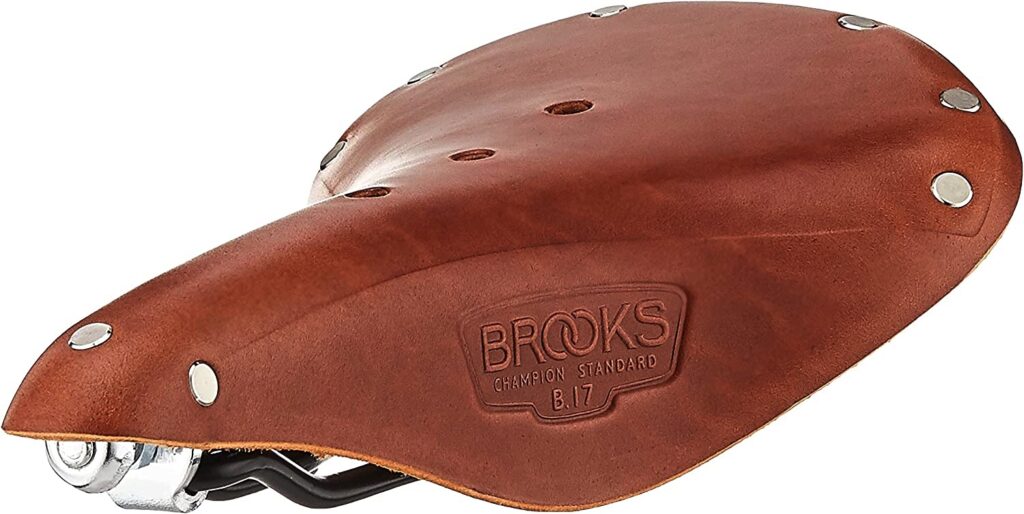
Another drawback to leather is that it is not water resistant. Therefore, it is a bad choice for rainy weather as it feels uncomfortable and stretches more quickly when soaked. On the other hand, it also dries and cracks under the scorching sun. As a result, you need to apply leather products. Leather wax like this will help maintain the quality and deal with cracks in the material. Leather conditioners like this also help keep the leather moist and free of cracks for a long time. Always ensure you consult the manufacturer’s care instructions before applying any product.
3. Cotton Mountain Bike Saddles
Saddles like these are constructed with a cotton canvas fitted on top. Cotton offers great comfort and adequate control for pedaling through varied terrains. It is airy and breathable, helping to relieve pressure on soft tissue areas. It also features good shock absorption for those bumpy rides. In addition, cotton is inherently flexible and only moves slightly as you pedal.
Like leather, cotton also gradually molds to your weight and shape. They are beautiful and malleable, offering excellent support on downhill rides. Some riders prefer cotton to leather saddles as they require much shorter break-in periods.
However, cotton saddles are not so great for winter rides and can feel quite cold in those conditions. So you will have to get some padded shorts/pants for riding. In addition, while some cotton saddles receive waterproof treatment, others are not water-resistant. As a result, you might need a waterproof saddle cover or pad like this. This will allow you to enjoy a dry saddle in rainy conditions.
Summary of Materials of Comfortable Mountain Bike Saddles
| Type of Bike Saddle Material | What Kind of Rider Should Use This Saddle? Why? | When Not to Use This Saddle? Why? | Example with Price |
| Synthetic Mountain Bike Saddle | Casual riders.It is very comfortable and does not require a break-in period. | Long endurance rides.It tends to compact and compress with use. | Bikeroo Memory Foam Bike Seat~$25 |
| Leather Mountain Bike Saddle | Cross Country riders.It is very durable and has plenty of flex. | Rainy conditions.It is not waterproof. | Vintage Classic Leather Cycling Saddle~$30 |
| Cotton Mountain Bike Saddle | Downhill bikers.It has great grip and support. | Winter season.It can feel uncomfortably cold. | Memory Cotton Bicycle Saddle~$30 |
Similarly, you may also be interested in looking at our mountain bike saddle price guide to gain an understanding as to how saddle materials effect saddle pricing. If so, be sure to read our related article to find out more.
Additionally, be sure to check out these tips and tricks for choosing a mountain bike saddle as well. Be sure to check that one out too.
Are Leather Bike Saddles Better Than Synthetic?
Whether leather bike saddles are better than synthetic saddles depends entirely on your personal preferences and the benefits that you are looking for in a mountain bike saddle.
Reasons why leather bike saddles are better than synthetic saddles, include they are sturdier, more durable, provide better grip, mold to fit the rider's body, and do not compress over time. Synthetic saddles are better for casual and recreational rides in rainy weather.
According to this research paper from the Methods and Protocols Journal, saddle sores are quite common among cyclists. They can cause anything from mild discomfort to severe ongoing pain affecting riding. They are skin ailments resulting from friction, heat, pressure, moisture, and bacteria in the saddle area as explained in our guide on how to reduce mountain bike saddle pain. You must therefore choose saddle materials with these issues in mind. Leather saddles particularly help prevent these sores, as this page from the manufacturer Selle Anatomica discusses.
Here are the reasons why leather saddles are better:
Reason 1. Leather Bike Saddles Do Not Compress Over Time
One major disadvantage to synthetic gel and foam saddles is that they compress over time and with use. The padding wears out, creating discomfort and shifting pressure from your sit bones to soft tissues. In contrast, leather saddles do not compress or deform. Once they break in, they maintain their strength and structure for long endurance rides over various terrains.
Reason 2. Leather Bike Saddles Mold to Fit the Rider's Body Shape
Although leather saddles are typically stiff and uncomfortable out of the box, they do get much better with time. They require a break-in period, usually ranging from 200 to 300 miles. However, leather saddles have the ability to shape and conform to your body over time. With use over time, they will soften and feel much more comfortable. This ensures the bike saddle is the exact shape of your sit bones, providing a very enjoyable ride.
To help speed up the break-in time, you can apply leather-specific oil like this. Rub a small amount over the top surface of the leather seat. This should help soften the leather and help it adapt to your body weight and shape.
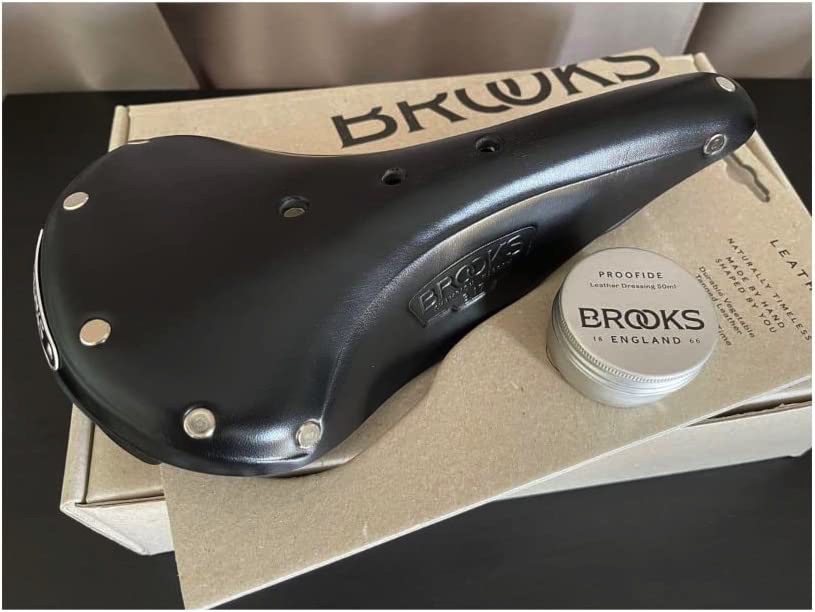
Reason 3. Leather Bike Saddles Are Sturdier and More Durable
Generally, leather bike saddles are sturdier and more durable than synthetic saddles. If maintained properly, the saddles are extremely durable and long-lasting. They are resilient and can handle all sorts of rough terrains and harsh conditions. Synthetic materials, on the other hand, tend to deteriorate faster. However, leather saddles require a bit of extra maintenance to keep them functioning adequately.
For optimal care, you will have to keep them dry while riding and when in storage. Apply recommended leather care products to help protect against rain and heat. If you end up riding in the rain, ensure you wipe the saddle dry at the end of the ride. Also, ensure you rub a bit of oil into the saddle regularly to prevent it from drying out. You can make use of a leather solvent to take care of any spots or blotches. With the right amount of care, your saddle will be even more comfortable and will last a lifetime.
If you're interested in regular maintenance of your saddle and other bike components, check out our ultimate list of tools for mountain bike maintenance guide.
Reason 4. Leather Bike Saddles Offer Better Grip
Leather is preferred for mountain biking as it provides a firm grip. This is due to its higher friction coefficiency. It secures the rider in place and aids navigation when the road gets twisty. In addition, leather seats ensure the rider doesn't slide around in the seat too much on rough terrains. It also ensures you maintain sufficient control when pedaling uphill or downhill on your bike. To learn more about improving grip and control of your bike over varied terrains, read our article on common mountain bike grip upgrades.
Types of Mountain Bike Saddles
The two common types of mountain bike saddles available on the market vary greatly and both have beneficial features.
Common types of mountain bike saddles are cushioned mountain bike saddles and performance mountain bike saddles.
Cushioning MTB Bike Saddles
As the name suggests, cushioning bike saddles are designed with comfort in mind. They feature additional cushioned padding of two main types: Gel cushioning and foam cushioning. They are particularly common for recreational and casual urban rides. These saddles ensure even distribution of pressure, helping to increase ride comfort. They are the preferred option for riders who struggle with saddle sores and other kinds of saddle discomfort. To learn how to improve mountain bike saddle comfort, read through our article.
Combining two different kinds of padding is an idea that seems great but really isn't. It creates highly uncomfortable and painful pressure points. Therefore, it is best to stick with the padding most suited for your riding needs.
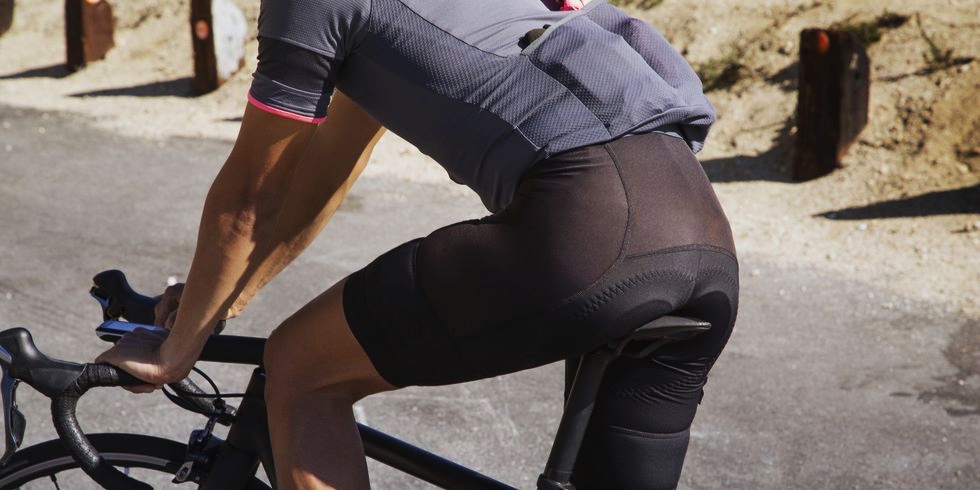
Let's take a look at the two main types of cushioned MTB saddles in detail:
Type 1. Gel Mountain Bike Saddles
Gel mountain bike saddles like these are made from gel synthetic material as additional padding. Many modern saddles make use of gel due to the maximum support and comfort offered. The material is soft and elastic, helping to absorb and distribute the weight evenly. This helps to eliminate uncomfortable pressure points in a natural way. In addition, it also has good breathability due to its honeycomb design. This helps to promote better air circulation. As you ride, gel material conforms to your body shape and follows your movements to deliver immediate comfort.
However, one downside is that gel gets compacted quite easily. With constant use, it loses its springiness and plushness. This can cause discomfort as your body sinks into the gel saddle and pressure shifts to your soft tissue areas.
This type of mountain bike saddle is usually best for beginners taking casual rides. Due to its water resistance, it works well in all sorts of harsh conditions, including rain and mud. In addition, the flexibility allows the saddle to work well with uphill climbs. However, due to its tendency to compact easily, it is not ideal for long endurance rides.
Type 2. Foam Mountain Bike Saddles
Saddles with foam padding are popular among mountain bikers. This is because they are lightweight and quickly spring back into shape after being compressed. It offers excellent support for your backside and absorbs impact and vibrations on bumpy rides. This helps to guarantee comfort on mountain bikes. Some foam saddles feature soft memory foam, which molds to the rider's shape. Others make use of firmer foam which does not compact quickly from use. This makes them excellent choices for longer rides, riders with well-conditioned muscles and sit bone area, and riders weighing more than 200 lbs.
Many modern saddles now feature construction with foam padding of varying density in specific areas. This helps relieve pressure at significant points, preventing any chance of discomfort. In addition, foam saddles do not require any form of breaking in and are pretty easy to clean and maintain. However, although they do not compress or deform easily, they still eventually wear out and deteriorate.
Foam saddles are great for road riders and racers, as they are comfortable and easy to install and replace. In addition, they do not feel stiff and uncomfortable initially, making them great options for short daily commutes. You can easily go on rides without changing into cycling clothes and padded shorts.
Performance MTB Saddles
Performance saddles like this are designed to maximize efficiency and power transfer while pedaling. As a result, they typically feature minimal or no cushioning. They simply come with durable and comfortable covers to compensate for the absence. Performance MTB saddles help improve aerodynamics and enhance the bike's performance. In addition, they prevent chafing and rubbing on long rides and challenging terrains.
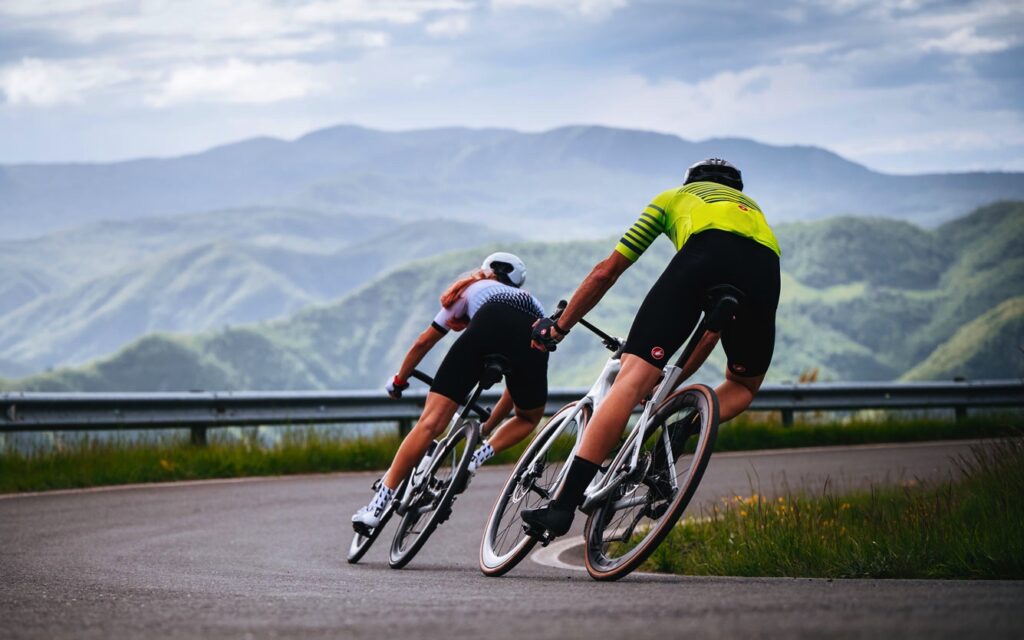
Let's delve into the main types of performance saddles available:
Type 1. Mountain Bike Saddles Without Cushion
Bike saddles like these have zero padding or cushioning. However, the saddle covers make them exceptionally comfortable despite not having any padding. Although many riders find them uncomfortable when brand new, bike saddles without cushioning gradually break in with frequent use. They mold to the rider's weight and body shape.
Saddles without cushions are great for hot summer rides as they tend to stay cooler. However, due to the relatively long break-in periods, they are not ideal for recreational cruising. Nevertheless, they are usually favored by professional bikers and endurance cyclists. If you're yet to find a cushioned saddle that works for you, then consider getting a zero-cushioned bike saddle.
Type 2. Leather Mountain Bike Saddles
Saddles like these that are constructed with leather give your bike a lush, premium feel and look. They are high-quality and durable, designed to take a lot of abuse on various terrains. This enables the saddles to withstand and resist vibrations, impacts, and shocks when navigating through gravel paths. One of the major advantages of leather is that it offers tailor-made comfort specifically for you. This is due to its ability to soften with time and conform to a rider's body shape. In addition, leather does not compress or deform with increased use. As a result, it is a popular option for long-distance off-road rides.
However, leather saddles are not great for muddy or rainy conditions as they are not waterproof. They are also not popular for short casual rides as they require a substantial break-in period. However, they are great for rough terrains due to their great degree of flexibility and strength. They offer the ultimate support for improving cycling performance.
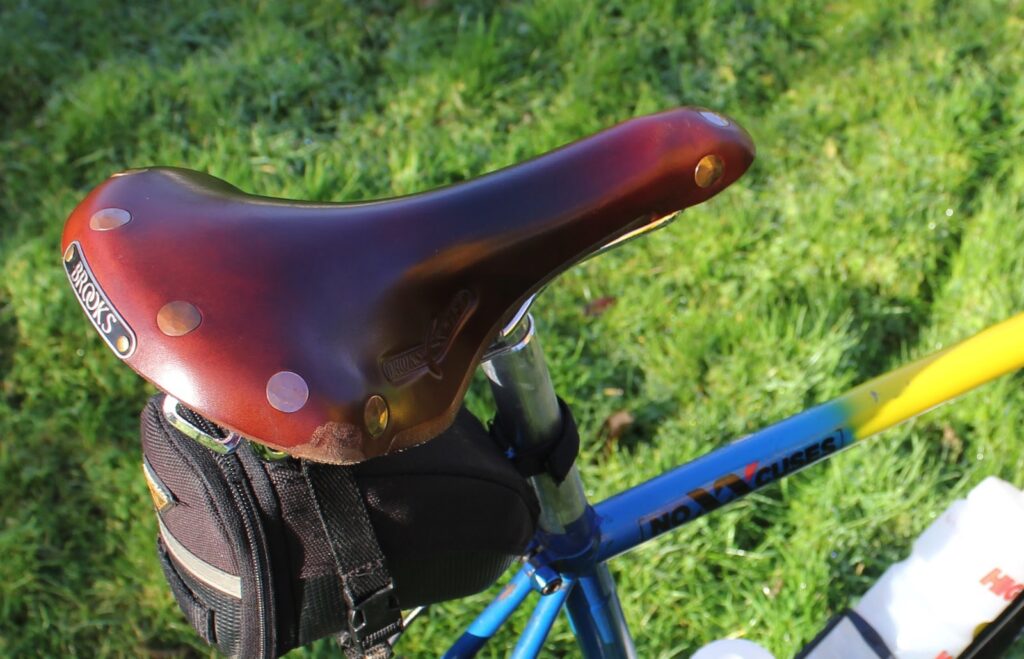
Type 3. Cotton Mountain Bike Saddles
Cotton is another excellent high-performance bike saddle material. It is regarded as an effective all-round material for bike saddle covers as it is extremely durable, comfortable, and breathable. Saddles made with cotton are less likely to overheat due to exposure to the sun as they do not absorb heat. This allows you to stay cool in tropical climates and long hot rides. In addition, they come in a wide variety of patterns, designs, and colors. They are cheaper than leather options and are also eco-friendly. These saddles are practically maintenance-free, as they are effortless to clean and maintain.
Like leather, cotton saddles are resilient to wear and tear, so they work well for rough off-road terrains. They also work well for recreational bikers as well as professional cyclists. In addition, they provide sufficient grip for downhill biking. However, due to their coolness, they can feel uncomfortable in winter.
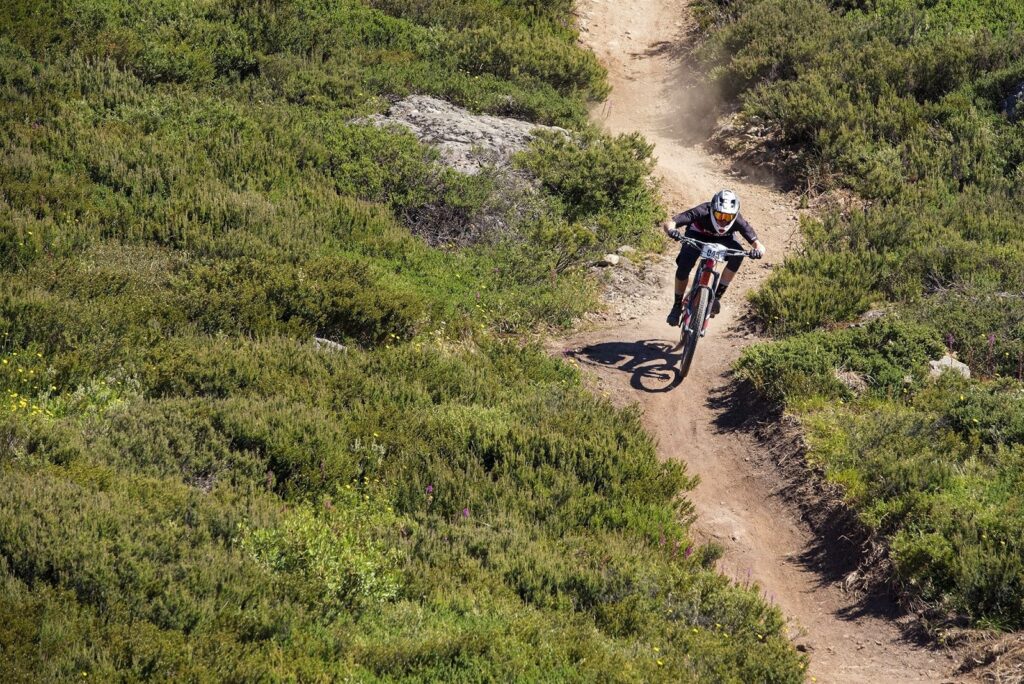
How Do I Choose a Mountain Bike Saddle? Finding the Most Comfortable Mountain Bike Seat
Mountain bike seats are a very individual choice, which is based on a lot of factors such as your body structure, riding style, and preferences. A change in your saddle can completely transform your riding comfort and endurance.
To choose a mountain bike saddle consider the width, level of comfort, height, and preferred riding posture.
If you're just starting on your very satisfying mountain bike journey and you’d like to know what mountain bike you should buy, our article will come in handy.
To help you select the best option, this section will cover steps to finding the most comfortable mountain bike seat:
Step 1. Choose the Correct Bike Saddle Width Using a Bike Saddle Size Chart
There are different sizes of bike saddles designed to accommodate different body types. For optimal comfort, choose a saddle width that adequately supports your sit bones – not too narrow or too wide. To get the right saddle size, you need to measure your sit bone width, as explained in this video tutorial by Arts Cyclery, and correlate it to the appropriate saddle width using a bike saddle size chart from this post by Selle SMP.
Many bike shops have a gel or foam pad for measuring your sit bone width. You can also take the measurement at home with a piece of cardboard or aluminum foil. First, place the cardboard or foil on a chair and sit down with your knees at 90º to the floor. Next, stand up and mark a vertical line on each side of the sit bone impression formed. Then make a dot in the center of each line and measure the distance between the two dots. Finally, add 20mm to the sit bone width measured to get your saddle width.
Step 2. Use a Bike Saddle Selector to Find the Most Comfortable Bike Seat
You can also make use of a saddle selector on different manufacturer sites online to find your perfect saddle. This saddle selector from Pro Bike Gear is a good option if you need one. You will need to specify your riding style and discipline as bike saddles have different designs for different particular disciplines. The saddle selector also takes into account your gender due to anatomical differences. It also notes your flexibility on the handlebars, riding posture, preferred saddle length, and any existing saddle discomfort. Based on the criteria you provide, the saddle selector then picks a set of saddles for your unique riding needs.
We actually provide some really handy tips regarding where to hold mountain bike grips to maintain proper posture so that you can maintain optimal comfort at all times.
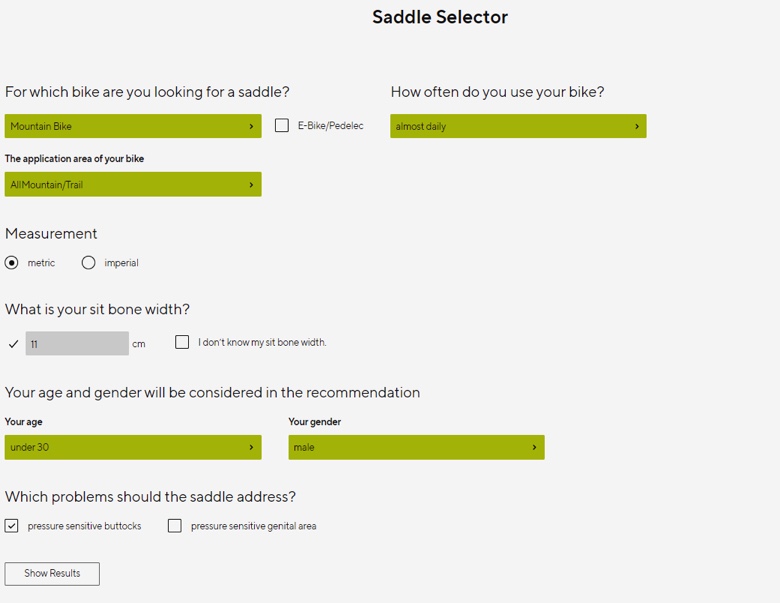
Step 3. Choose Your Bike Saddle Height Using a Saddle Height Calculator
For the best riding experience, you need to have the perfect saddle height. The saddle height should compensate for and accommodate your pedaling on different terrains. To find the approximate saddle height best suited for you, you can utilize a saddle height calculator.
First, stand barefoot on the ground and measure your height. Also, measure your leg length (inseam) by measuring the distance from the ground to your crotch. Then, enter the measurements into the calculator to get the optimal saddle height. You will also need to enter your gender. The calculator will give you a resulting number that represents the distance between the center of the bottom bracket and the top of the saddle. You can then adjust the saddle height accordingly. For more information, check out our article on choosing the ideal MTB saddle position.
Step 4. Consider Your Riding Posture
Another essential factor to consider when choosing a saddle for comfort is the riding position. Different riding postures will require different saddle padding, shape, and size. You must consider your riding style and discipline before investing in a saddle.
Mountain bikers tend to hold more forward and aggressive positions. As a result, the saddle should have an aerodynamic shape and feature adequate padding to relieve pressure in the forward part of the pelvic area. Leather is also a great option as it allows you to keep your weight forward and have adequate control while riding steep terrains. Touring bikers typically favor more upright positions. These positions will require padding further back on the saddle for optimal support.
Step 5. Take the Saddle for a Test Ride
Ultimately, there is no one-size-fits-all rule when it comes to bike saddles or mountain bike saddle materials. You might need to experiment and ride with different brands and types before you find the right one. Many shops will allow you to fit on test saddles for test rides. Some manufacturer brands also have a return policy where you can try the saddle for a specific period of time and return it if it doesn't fit properly. Some also offer a free exchange between their saddle models until you find the right one for your needs. This article from Bike Rumor explains the Bike Saddle Box program which allows you to actually try out saddles before buying one.
When testing a saddle, look for any numbness or pressure on your soft tissue area. Also, check that you do not experience any chaffing or rubbing as you ride. The best saddles feel like an extension of your own body instead of something you're sitting on top of. We recommend you spend at least an hour riding with the saddle as some require a break-in period before becoming comfortable.
